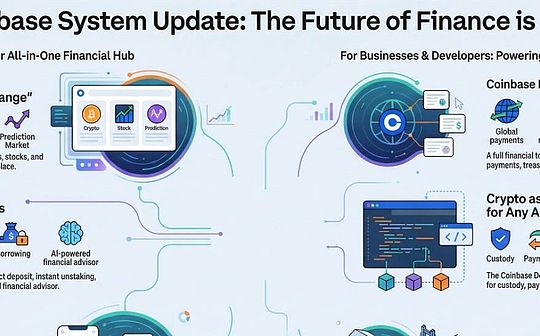
Author: IGNAS Source: IGNAS | Defi Research Translation: Shan Ouba, Bit Chain Vision
I like it very muchmeme coin, But this kind of “fanatic” seems to be close to the limit.
My Crypto X dynamic and information flow floodedmeme coinThe posts (and Pudgy Penguins), so that the development of many major crypto industries has been buried.The recent market decline gave me the opportunity to study these progress carefully.However, this decline has not lasted too long.
>
In this article, I want to share10 DEFI and wider dynamic dynamics in an extensive encryption ecosystemThese are worth your close attention.
1. Avalanche 9000: L1 is the new L2?
Avalanche has just released its maximum upgrade–Avalanche 9000, Make the L1 blockchain easier, cheap and flexible.
L1 is the new L2?The old subnet model has disappeared.
Developers no longer need to verify the main network or pledge 2000 AVAX (worth about $ 100,000), and only pay a small amount of continuous costs, which greatly reduces costs.
>
It sounds like POLKADOT, and it is a bit like cosmos, right?
灵感来自以太坊的EIP-4844(Proto-Danksharding), which makes the cost of Avalanche L1 close to Rollup based on Celestia, but it has better interoperability and reliability.
This upgrade also introduces the verification device limited to L1, allowing each L1 to manage its own rules, whether it is POS or authoritative proof of the blockchain.This means better token economics and value premium.
It reduces the cost of running the verification device from 2K Avax ($ 100,000) to 1.33 Avax.
>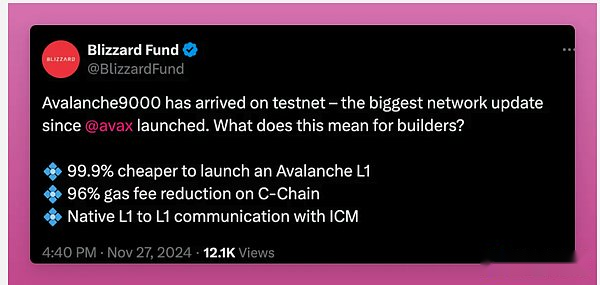
Avalanche launched it namedRetro9000The US $ 40 million funding plan has 700 L1 projects under development, covering multiple fields from games to DEFI.
Avalanche is successfully attracted the traditional finance partner through the tokenization, and it has attracted the ascending partnerOff the gridGame items.In the competition between Solana and Ethereum, Avalanche seemed to find its own market positioning.
2. The combination of near and AI
AlthoughBaseandSolanaIt triggered FOMO (such as Virtuals and AI16Z) due to the continuous release of AI agency related items, butNearIt is quietly opening its own AI innovation path.
Near has supported the function of the proxy -driven chain and is developing more tools and functions.
>
Its difference is that the native chain abstraction of the multi -chain AI agent makes it easier for developers to build an interconnected system.
In addition, Near Intents also introduced a new trading model that can achieve cross -chain settlement between AI agents, services and end users.Personally, the coolest cooperation is the cooperation between Infinex and Near, so you can trade BTC, XRP or anything on a decentralized platform.
>
Near launched Near.ai, a AI assistant, which can act by connecting other AI agents and cross -web2 and web3 services.您需要一个 Near 钱包才能登录。
To be honest, the wallet experience on Near was quite bad before, but now the situation is much better (I recommend Near Mobile).
Interestingly, a NEAR -based social agent began to hold Twitter Spaces.
In addition, Near also launched a research center to explore new AI models and cooperate with Delphi to carry out the AI accelerator plan to support the builders in the field.
It is worth noting that the blind computing blockchain NILLION Network is built on the basis of Near, bringing privacy protection technology for private LLM training and sensitive data reasoning.
This can release the entire potential of artificial intelligence owned by users.
3.liquity v2 release
The price of LQty rose 120%within a month.reason?
•The market is generally bullish
•Release of liquity v2
There are problems with traditional DEFI lending models:
-
The capital market like Compound and AAVE sets interest rates based on utilization rates, resulting in unpredictable costs.
-
The adjustment of governance protocols such as MakerDao is slow, and interest rates are often stuck due to delay in governance.
Even the fixed cost model of liquity V1 cannot adapt to market changes.
Liquity v2This problem is solved through the interest rate set by the user and the BOLD (a stable currency focusing on decentralization, user control and income).
The borrower opens “TROVE” to set interest rates -low interest rates for savings, and higher interest rates are used to avoid redemption.Trove with the lowest interest rate will be redeemed first.
>
LIquity V2’s LTV is as high as 90%, lever is as high as 11 times, and the efficiency is extremely high.
Borrowers can not only use ETH, but also use LST such as LSTH and RETH as mortgages, and they can still get pledge rewards while borrowing BOLD.
Therefore, BOLD is completely supported by ETH and LST, which can be exchanged at any time without being affected by the risk of Tradfi.
Unlike USDC, it does not rely on RWA, thereby avoiding trading opponents and reviewing risks.It is maintained with a simple mechanism with a simple mechanism:
-
If $ bold falls below $ 1, arbitrage will encourage redemption ETH.
-
If $ BOLD rises to more than $ 1, lower borrowing interest rates will increase supply.
The stable pool depositee can obtain 75% of the agreement revenue through BOLD and ETH liquidation income, and 25% of the cost will be used to support liquidity (PIL) to support BOLD liquidity in DEFI.
A huge change is the Forkonomics of liquity V2, because Liquity is one of the most bifurcated protocols in Defi.
Now, the team needs to obtain a license to use the liquity code (and some airdrops of LQty holders), but in return, they will get LIquity’s support, liquid network access permissions, shared security resources, and potential LQty rewards.
This is a win -win situation: the fork has received better support, and BOLD can expand across the chain without the risk of usual hacking or poor management.
4. Newle new protocol -BOROS
Most people think that Pendle V3 is only another fork or small update, but Pendle has unexpectedly launched a new direction:Boros, Pendle’s “Brother Agreement” brought income transactions into a new field.
BOROS’s core highlight:
• Special forLeverage income transactionAnd design.
• Users can use leverage transaction yields.
Boros focuses onFunding rate(The cost of lending leverage position) solves the current lack of pain points for hedging or effective transaction methods for funding rates.
what is the problem?So far, there is no effective way to hedge or trade these interest rates.This is the role of BOROS.With it, traders can:
-
Hedry financing interest rates are open to obtain predictable returns.
-
Use leverage to speculate on financing interest rate fluctuations
Taking Ethena as an example, its profitability relies on financing interest rates to a large extent.With BOROS, Ethena can hedge fluctuations and lock stable income.At the same time, speculators can use the rise and fall of financing interest rates to obtain greater profits.
You may ask, why is it a financing interest rate?
PERP Exchange handles a transaction volume of $ 150 to 20 billion per day, and financing interest rates are the core of these market operations.However, they were ignored in DEFI.
BOROS can make financing interest rates.This means that agreements, businessmen and traders can now integrate financing interest rate strategies into their investment portfolio.
Pendle has now developed into a comprehensive income trading platform.V2 and BOROS perfectly complement:
-
V2 focuses on the benefits of tokens, such as pledge, RWA and BTCFI.
-
BOROS has in -depth research on financing interest rates and chain opportunities.
>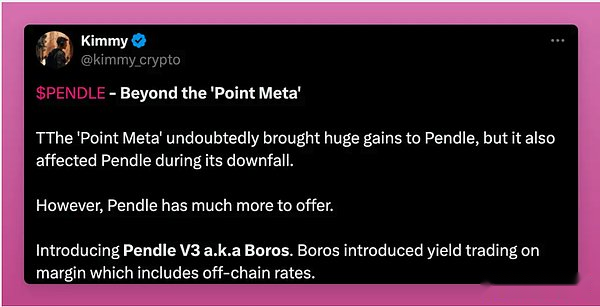
According to Pendle’s consistent practice, they simplified everything for the community.No new tokens.
The same $ PENDLE and VEENDLE tokens are supported by V2 and BOROS.The income distribution is also unchanged -80% is allocated to the holder of Vependle, 10% is allocated to the protocol vault, and 10% is used for operation.
>
As Points metadata gradually cooled, Boros arrived on time.
5.zircuit
This may be the most confusing L2 in the encryption.
Zircuit ended the first and second -season airdrops on November 20, and distributed 300 million tokens for recognition.They seem to be very generous to provide airdrops to each partner.
What is the next plan of Zircuit?How do they plan to maintain user participation and create real use cases for their token?
The answer seems to be the most popular topic at present: artificial intelligence.
Zircuit is developing a name calledGUD AI’s new productEssence
It is a AIXBT AI agent, which can be found Alpha.There is also a native AI token $ GUD, which requires a pledge of $ ZRC.
For the new L2, this is a good strategy.
Zircuit is the second layer, but it uses another method to achieve the second layer infrastructure.It is not only focused on extension, but also focuses on safety, efficiency and availability.
One of the main functions of Zircuit isSequence level security (SLS)EssenceAlthough most blockchain detects them after performing malicious transactions, SLS can even identify them before threatening the chain.
In the re -pledge era of Ethereum, LRT on Zircuit was very eye -catching and attracted more than $ 2 billion TVL.Zircuit’s main network is accelerating, and it has been launched:
-
Bridge between Ethereum and Ethereum.It takes only a few minutes to bridge, and the speed is amazing.Since its launch, Zircuit’s net deposits have jumped to $ 300 million.
-
Some native DEFI DAPPs, such as Zerolend and ELARA LABS for borrowing, are used to exchange and liquid mining Ocelex and DODO.
Recently, Zircuit distributed 2% of its supply to more than 190,000 Eigenlayer re -holders.
>
Zircuit received support from Binance Labs, Pantera Capital and Dragonfly Capital, but it has not been listed on Binance (perhaps soon).
6.starknet
Although the Strk airdrop was negatively affected, StarkNet has recently made significant progress, promoting the Layer 2 technology boundary, which is worthy of in -depth attention.
>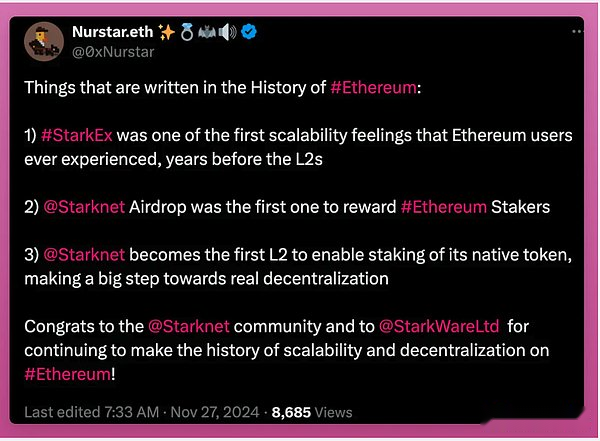
One of the major measures is to launch the pledge function of its native currency Strk.As the first L2, which provides the function of primary pledge, Strk pledge is now on the main network.Bitwise, a company managed $ 11 billion in encrypted assets and $ 3.5 billion pledged ETH, also officially joined the Starknet ecosystem to support Strk pledge.
At the technical level, the deployment cost was reduced to only $ 5, and the verification cost was as low as below $ 1.Through the efforts of multiple teams, SNARK can even verify that SNARK has provided the possibility for developers to build real applications based on zero -knowledge technology (such as privacy authentication or security document verification).
In addition, V0.13.3 Update has reduced the cost of Blob GAS by 5 times through more intelligent compression and block integration technology, effectively controlling the cost, and even the increase in the amount of BLOB in Ethereum can maintain low cost.Starknet’s future plan includes more efficiency upgrades, even Vitalik affirmed this.
>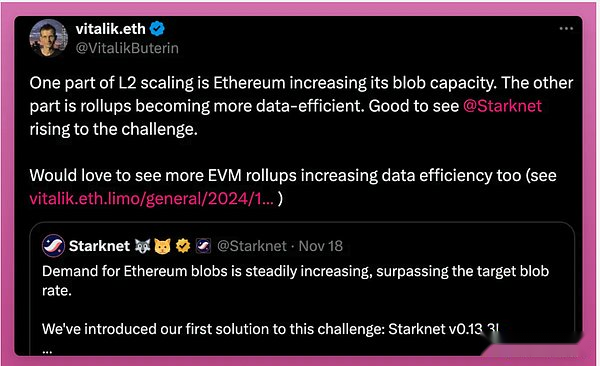
Another exciting progress is to trust the Bitcoin Bridge (OP_CAT Concept Verification Bridge) that it has cooperated with SCRYPT.This measure shows that the interaction between StarkNet and Bitcoin can achieve an important door for interoperability, and it is expected to unlock more interesting use cases.
7.mode
After the airdrop, Mode launched two important measures:Vemode and AIFI ecosystems.
MODE is the first protocol based on OP stack Layer 2.Through Vemode, users can pledge the Mode or Mode/ETH liquidity tokens to obtain the right to vote. The longer the pledge time, the maximum voting rights can reach up to 6 times.Unlike the traditional model, Vemode is not voting for specific liquidity pools, but focuses on supporting the growth of the entire ecosystem.In the third season, this system will be distributed by $ 2 million in OP incentives.In the future, it is also planned to introduce the bribery market and AI agents, simplify the participation process, and allow the AI agent to vote for users.
The real highlight of Mode is its attention to AIFI.With the $ 6 million fund provided by Optimism, the Mode is introducing AI agents into DEFI to simplify and expand the interaction.These agents can handle the tasks such as income agriculture, risk management and even governance, and almost do not require artificial intervention.
Mode’s AIFI ecosystem is based on the three -layer architecture:
-
AI Security Layer 2 Sequencer can detect and prevent malicious transactions from entering the blockchain;
-
The agent infrastructure on the chain deploys agents with partners such as Giza, Olas, and RPS AI. At the same time, it can allow proxy to learn and execute advanced strategies through Mode’s DAPP Intents SDK;
-
AI -driven interface, such as Mode’s AI wallet, makes DEFI easier to use by simplifying interaction.
To launch the AIFI ecosystem, Mode launched the AI Agent App Store, which is a AI agent discovery platform designed for Defi.Some highlight agents include:
-
GIZA’s ARMA, which is used to optimize the income of USDC in the capital market;
-
Olas developed Modius (is about to be launched), a AI -driven liquidity agricultural strategist;
-
Brian, make DEFI interaction more dialogue through natural language prompts;
-
Sturdy V2, AI -driven revenue insurance library, aims to optimize returns.
Therefore, Near, Mode, and Zircuit entered AIFI metadata on time.
8. polkadot
DOT tokens rose 75%within a month.There are many factors behind this.
In the past few months, Polkadot’s activities have reached a new height.The number of monthly transactions has reached a record high, and the key indicators (such as costs, active users and trading volume) have increased significantly.The annual growth rate of cost reaches 300%, and active users and transactions have also steadily increased.
>
The key factor to promote this momentum is the release of Polkadot 2.0.
The cost of running a parallel chain was about $ 16,700 per month, and in Polkadot 2.0, this cost was reduced to only 1,000 to 4,000 US dollars.The project can lease block space through DOT to create continuous demand for tokens.According to governance decisions, part of the income may be destroyed and reduce the tokens.This forms a positive cycle: the demand for DOT has increased, supply is reduced, and the entire ecosystem is more stable.
Polkadot’s cross -chain interoperability has also been significantly improved.Hyperbridge connects POLKADOT to networks such as Ethereum and BNB, which has promoted cross -chain interaction and created more possibilities for developers.The network performance is also very strong. It has handled more than 3.3 million transactions in a single day to prove that it is ready for large -scale applications (such as games, etc.).
>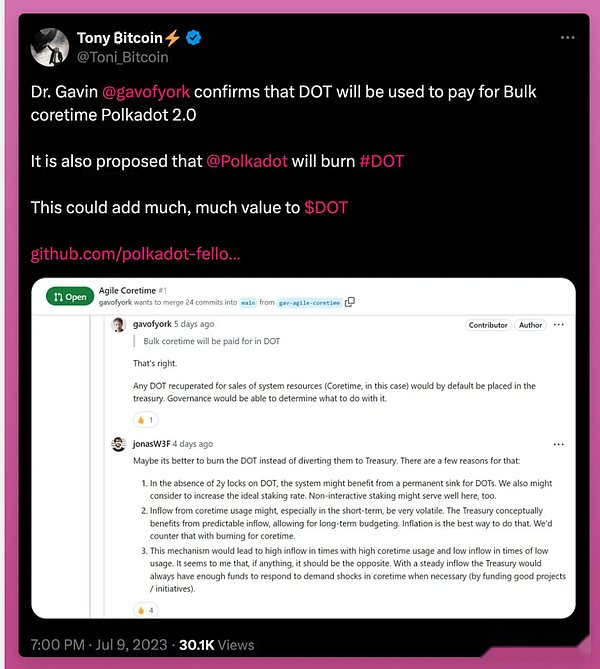
In the field of DEFI, Polkadot also performed well.The Hydration ecosystem has grown rapidly. Since October, active users have increased by 50%, and the cost has doubled to reach a record high.Hydration integrates transactions, loans and stable coins into a application chain. Its Omnipool simplifies liquidity and supports unilateral deposits. TVL has exceeded $ 68 million.Hydration’s stablecoin 2-USDT-USDC annualized yield is as high as 36%, including costs and VDOT rewards.
>
Hydration has recently launched a loan function, which is based on Polkadot’s AAVE V3 fork version.Its chain priority liquidation mechanism can be liquidated at the beginning of each block to effectively reduce borrower losses and prevent running attacks.At the same time, the liquidation fine will be converted into agreement income, benefiting HDX pledges, and supporting governance decisions.
9.Dydx
The competition in the PERP Dex field is getting stronger, and the leaders have experienced change … DydX, GMX, Vertex, now Hyperliquid.
However, I believe that the real loser is the CEX who loses to the emerging DEX that is lost to fast innovation.
Although Hyperliquid occupies the first place after successful airdrops, DYDX chose a more retail way and launched Dydx University, which includes a series of new features: instant market lists, Megavault and alliance programs.
>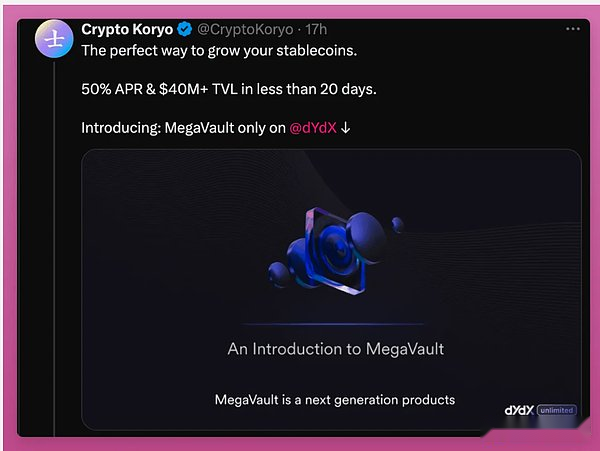
UseInstant market listAnyone can immediately create and trading markets without governance approval or waiting for a long time.It’s simple: Choose a market, save USDC in Megavault, and start trading.
This is a major advantage that CEX cannot provide.
MegavaultIt is the core of the system that provides liquidity for all markets by gathering USDC.
It provides funds for the market, and the depositor obtains passive income.Half of the cost of DYDX protocols flows to Megavault, which makes liquidity supply return.It is very similar to the Jupiter’s JLP Vauts.
DYDX also launched the Alliance Plan, which pays the recommended USDC commission for the recommender.The reason why Bybit can develop rapidly is part of the alliance plan 🙂
Trading awards, distribute 1.5 million US dollars of DYDX tokens per month, and provide a prize pool with up to 100,000 USDC for MEGAVAULT depositors.
Since then, DYDX has achieved some good results, with a financing of more than 40 million US dollars and an annual interest rate of 51%.
>
10.Aptos
Following SUI, APTOS is also the fastest -growing project based on MOVE blockchain in the field of TVL and DEFI. Its TVL has exceeded $ 1 billion for the first time, a year -on -year increase of 19 times.
With the TRADFI wave on APTOS, Berlaide expanded its Build Fund on Aptos. Aptos is the only non -EVM chain that has been integrated.
Franklin Dunpon also extended its chain to the US government monetary fund to APTOS (one of the seven supported chains).
Bitwise and Libre have launched their own token funds on the blockchain.
Tether launched native USDT on Aptos in August.Since then, the USDT supply on Aptos has been increasing.Since the beginning, USDT supply has increased from approximately $ 20 million to about 142 million US dollars.
>
Following Tether, Circle also announced the launch of native USDC and cross -chain transmission protocols (CCTP), and received support from STRIPE encryption products on Aptos.
As the native stable coins are injected into APTOS, the ecosystem is getting positive indicators. TVL continues to maintain more than $ 1 billion, and 1 million new users join the ecosystem.
Some DEFI milestones on Aptos:
Last year, the daily DEX trading volume on Aptos increased by 2,700%(28 times).
>
-
The leading lending agreement on AptosAries MarketsTotal locking volume (TVL) reaches a new high, exceeding800 million US dollarsTotal deposits, more than more than$ 450 millionBorrowed.
-
emojicoin dot fun, A APTOS -basedpumpdotfunThe project has been launched on the main network, and reported within 24 hours after the launch.16,700 independent addressEssence
I guessAPTFollowSUIThe pace, the latter is very good.I thinkSUIAs well asAPTAnd other L1 is competingSolanaThe market share, all these are competing at the execution level, andETH … is ETH!


